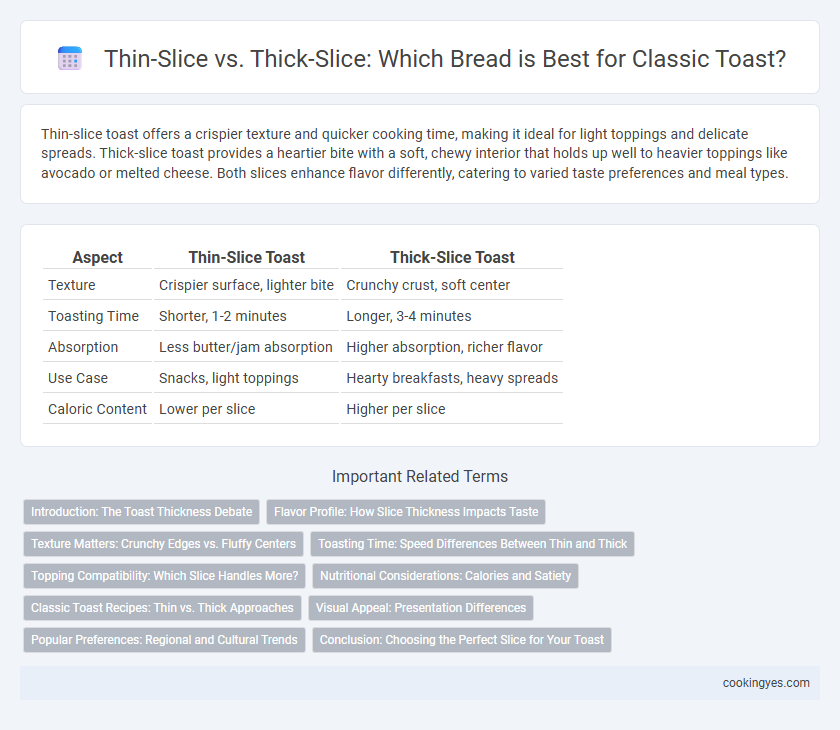Thin-slice toast offers a crispier texture and quicker cooking time, making it ideal for light toppings and delicate spreads. Thick-slice toast provides a heartier bite with a soft, chewy interior that holds up well to heavier toppings like avocado or melted cheese. Both slices enhance flavor differently, catering to varied taste preferences and meal types.
Table of Comparison
| Aspect | Thin-Slice Toast | Thick-Slice Toast |
|---|---|---|
| Texture | Crispier surface, lighter bite | Crunchy crust, soft center |
| Toasting Time | Shorter, 1-2 minutes | Longer, 3-4 minutes |
| Absorption | Less butter/jam absorption | Higher absorption, richer flavor |
| Use Case | Snacks, light toppings | Hearty breakfasts, heavy spreads |
| Caloric Content | Lower per slice | Higher per slice |
Introduction: The Toast Thickness Debate
Thin-slice toast offers a crisp texture and faster toasting time, enhancing breakfast efficiency and lightness. Thick-slice toast provides a denser crumb and a chewy interior, ideal for hearty toppings and sustained satiety. Choosing between thin and thick slices depends on desired texture, toasting duration, and meal purpose.
Flavor Profile: How Slice Thickness Impacts Taste
Thin-slice toast offers a crispier texture and more pronounced browning, intensifying the toasty, caramelized flavors due to greater surface area exposure. Thick-slice toast retains a soft, airy interior that balances a mild, buttery flavor with a slightly crunchy crust, enhancing the overall mouthfeel. Slice thickness directly influences the Maillard reaction intensity, making thin slices ideal for sharper, more robust taste experiences while thick slices provide a hearty, mellow flavor profile.
Texture Matters: Crunchy Edges vs. Fluffy Centers
Thin-slice toast delivers a higher crust-to-crumb ratio, resulting in consistently crunchy edges that enhance the overall texture experience. Thick-slice toast preserves a fluffy, airy center while maintaining a golden-brown crust, creating a satisfying contrast between softness and crunch. The choice between thin and thick slices ultimately affects the balance of textures in classic toast, influencing preference based on desired crunchiness and tenderness.
Toasting Time: Speed Differences Between Thin and Thick
Thin-slice toast generally requires 1 to 2 minutes to achieve a golden-brown crispness due to its reduced thickness, allowing heat to penetrate quickly. Thick-slice toast typically takes 3 to 5 minutes, as the heat needs more time to evenly toast the denser interior without burning the surface. The difference in toasting time is crucial for achieving optimal texture and flavor in classic toast preparations.
Topping Compatibility: Which Slice Handles More?
Thick-slice toast offers superior topping compatibility by providing a sturdy base for heavier ingredients like avocado, peanut butter, or multiple layers of cheese, preventing sogginess and breakage. Thin-slice toast excels with light and crisp toppings such as butter, jam, or honey, allowing flavors to complement the delicate crunch without overwhelming the bread's texture. Choosing between thin-slice and thick-slice ultimately depends on the desired topping weight and texture balance to optimize taste and structural integrity.
Nutritional Considerations: Calories and Satiety
Thin-slice toast contains fewer calories per slice, making it a preferred choice for calorie-conscious individuals, but it may offer less satiety due to smaller portion size. Thick-slice toast provides more calories and increased fiber content, contributing to prolonged fullness and better appetite control. Choosing between thin and thick slices can impact daily caloric intake and hunger management, essential factors for balanced nutrition and weight control.
Classic Toast Recipes: Thin vs. Thick Approaches
Classic toast recipes differ significantly when using thin-slice versus thick-slice bread, impacting texture and flavor absorption. Thin slices toast quickly to a crisp, ideal for delicate toppings like butter or jam, while thick slices retain a soft, airy interior, perfect for hearty spreads like avocado or nut butter. Selecting the appropriate slice thickness enhances the overall eating experience by balancing crunchiness and moisture retention in traditional toast preparations.
Visual Appeal: Presentation Differences
Thin-slice toast offers a light, crisp texture with more evenly browned edges, visually emphasizing a delicate golden hue that enhances plating aesthetics. Thick-slice toast presents a robust, rustic appearance with pronounced crust contrast and a fluffy interior visible at the slice edges, appealing to those favoring hearty servings. The visual distinction between thin and thick slices influences presentation style, with thin slices suited for elegant arrangements and thick slices conveying a warm, substantial appeal.
Popular Preferences: Regional and Cultural Trends
Thin-slice toast is favored in regions like the UK and Japan, where crisp texture and quick toasting are culturally preferred. Thick-slice toast gains popularity in North America and Australia, prized for its soft interior and ability to hold generous toppings like avocado or peanut butter. These regional preferences often reflect local breakfast traditions and available bread types, influencing consumer choices.
Conclusion: Choosing the Perfect Slice for Your Toast
Thin-slice toast offers a crispier texture and faster toasting time, ideal for light toppings and quick snacks. Thick-slice toast delivers a soft, fluffy interior with a sturdy crust, perfect for hearty spreads and open-faced sandwiches. Selecting the perfect slice thickness depends on your preferred texture, topping type, and cooking method to achieve the ultimate toast experience.
Thin-slice vs thick-slice for classic toast Infographic

 cookingyes.com
cookingyes.com